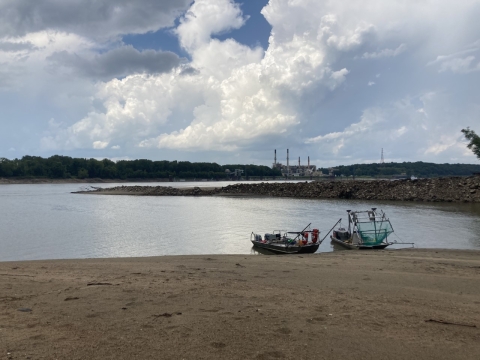About Us
We work with state, federal, and academic partners (among others) to understand and manage populations of aquatic invasive species invasive species
An invasive species is any plant or animal that has spread or been introduced into a new area where they are, or could, cause harm to the environment, economy, or human, animal, or plant health. Their unwelcome presence can destroy ecosystems and cost millions of dollars.
Learn more about invasive species , restore habitat for native species (fishes and other aquatic organisms), and create recreational opportunities, restore habitat, and decrease wildlife conflict on Department of Defense lands. Our office plays a pivotal role in the management of invasive silver and bighead carps and the responsible use of Department of Defense lands in the Midwest.
What We Do
Combined, the Carterville and Wilmington offices work in several states with many partners to maintain diverse, self-sustaining populations of fish and other aquatic organisms and habitats in the region for the benefit of the American people.
The goals of the office are to:
Prevent new introductions and minimize range expansion of aquatic invasive species invasive species
An invasive species is any plant or animal that has spread or been introduced into a new area where they are, or could, cause harm to the environment, economy, or human, animal, or plant health. Their unwelcome presence can destroy ecosystems and cost millions of dollars.
Learn more about invasive species
Early detection monitoring of invasive silver, bighead, grass, and black carps along the upstream edge of their known range
Maintain diverse, self-sustaining fish and other aquatic resource populations and their habitats (e.g., removing barriers to fish passage fish passage
Fish passage is the ability of fish or other aquatic species to move freely throughout their life to find food, reproduce, and complete their natural migration cycles. Millions of barriers to fish passage across the country are fragmenting habitat and leading to species declines. The U.S. Fish and Wildlife Service's National Fish Passage Program is working to reconnect watersheds to benefit both wildlife and people.
Learn more about fish passage )
Ensure sustainable use of natural resources on Department of Defense lands
Enhance recreational fishing opportunities on national wildlife refuges
Aid in the recovery of fish and mussel populations protected under the Endangered Species Act of 1973, as amended (16 U.S.C. et seq) and restore declining populations of native species
Our Organization
Our Species
The Carterville Fish and Wildlife Conservation Office and Wilmington Substation work with several species, including invasive carps (i.e., silver, bighead, grass, and black carps), Indiana bats, and northern long-eared bats. The primary focus for our office is to work with our partners to prevent invasive carps from entering the Great Lakes. Secondarily, we manage habitat for the Indiana bat and northern long-eared bat (both listed under the Endangered Species Act) through the Sikes Act.
Projects and Research
Staff at the Carterville FWCO and Wilmington Substation work on the following projects to accomplish our goals:
Early Detection and Monitoring for invasive silver, bighead, grass, and black carp use fish capture gear (e.g., boat electrofishing, electrified dozer trawl, mini-fyke nets) to detect these species at the upstream edge of their known range.
Hydroacoustic Sonar Surveys use split-beam hydroacoustics (i.e., sound waves) to detect underwater fish targets and allows biologists to analyze the density and size structure structure
Something temporarily or permanently constructed, built, or placed; and constructed of natural or manufactured parts including, but not limited to, a building, shed, cabin, porch, bridge, walkway, stair steps, sign, landing, platform, dock, rack, fence, telecommunication device, antennae, fish cleaning table, satellite dish/mount, or well head.
Learn more about structure of fish communities throughout a large area. When coupled with fish capture data, biologists use hydroacoustics to determine relative abundances and size structure of silver and bighead carp populations in specific areas.
Acoustic Telemetry uses a combination of stationary receivers and acoustically tagged silver and bighead carp to assess fish movements, habitat use, and behavior. Data from the receivers are then used to inform population models to assess management strategies for these species.
Environmental DNA (eDNA) is a surveillance tool used to monitor specified areas for the presence of an aquatic species. DNA from a species of interest may be present in the environment through the shedding of skin cells, fecal material, or other processes. Currently, eDNA sampling methods are used to monitor for the presence of silver and bighead carp DNA. Sampling for eDNA occurs primarily at or beyond the upstream edge of the known distribution for these species where their densities are thought to be low, and they are difficult to capture. Detections of silver or bighead carp eDNA may indicate the presence of the species and are used to inform future sampling efforts targeted at physical detection (e.g., electrofishing and netting).
Barge Entrainment Mitigation studies are designed to evaluate the probability that cargo barges, which routinely move between the Mississippi River Basin and the Great Lakes, unintentionally trap fishes (i.e., silver and bighead carps) and transport them between these systems. These studies also examine methods of reducing the probability of these events occurring to ensure that silver and bighead carps do not invade the Great Lakes.
National Fish Passage Program goals are to restore native fishes and other aquatic species to self-sustaining levels by reconnecting habitats that have been fragmented by artificial barriers (e.g., dams). Reconnecting previously fragmented habitats results in positive ecological changes.
Visit Us
Our work area and shop are not generally open for tours, so we encourage visitors to email or call (618) 997-6869to prearrange a visit.
Get Involved
Volunteering opportunities may be available. Please check with the office (618) 997-6869.




